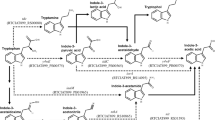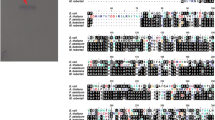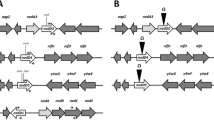Abstract
Our previous work showed that an enoyl-ACP reductase gene fabI1 of Sinorhizobium meliloti was down-regulated in the nifA mutant nodule bacteria. To gain a better understanding of fabI1 gene, a single site insertion mutant was constructed in this study. The fabI1 mutant was retarded in cell growth, and its ability to grow on media with high concentration of NaCl was reduced. In addition, the mutant was completely defective in swarming phenotype. During symbiosis, the fabI1 mutant had delayed nodule formation on host plants. Despite the fact that FabI1 protein showed 66% identity with another enoyl-ACP reductase FabI2 in S. meliloti, defects in fabI1 were not rescued by the plasmidborne version of fabI2. This indicated the different functions of the two FabI proteins in S. meliloti.
Similar content being viewed by others
References
Jones K, Kobayashi H, Davies B W, et al. How rhizobial symbionts invade plants: the Sinorhizobium-Medicago model. Na Rev Microbiol, 2007, 5: 619–633
Gage D J. Infection and invasion of roots by symbiotic, nitrogen-fixing rhizobia during nodulation of temperate Legumes. Microbiol Mol Biol Rev, 2004, 68: 280–300
Perret X, Staehelin C, Broughton W J. Molecular basis of symbiotic promiscuity. Microbiol Mol Biol Rev, 2000, 64:180–201
Meade H M, Long S R, Ruvkun G B, et al. Physical and genetic characterization of symbiotic and auxotrophic mutants of Rhizobium meliloti induced by transpon Tn5 mutagenesis. J Bacteriol, 1982, 149: 114–122
Marketon M M, Glenn S A, Eberhard A, et al. Quorum sensing controls exopolysaccharide production in Sinorhizobium meliloti. J Bacteriol, 2003, 185: 325–331
Luo L, Yao S Y, Becker A, et al. Two new Sinorhizobium meliloti LysR-type transcriptional regulators required for nodulation. J Bacteriol, 2005, 187: 4562–4572
Davies B W, Walker G C. A highly conserved protein of unknown function is required by Sinorhizobium meliloti for symbiosis and environmental stress protection. J Bacteriol, 2008, 190: 1118–1123
Magnuson K, Jackowski S, Rock C O, et al. Regulation of fatty acid biosynthesis in Escherichia coli. Microbiol Rev, 1993, 57: 522–542
Lai C Y, Cronan J E. Isolation and characterization of β-ketoacyl-acyl carrier protein reductase (fabG) mutants of Escherichia coli and Salmonella enterica serovar Typhimurium. J Bacteriol, 2004, 186: 1869–1878
Bergler H, Fuchsbichler S, Hogenauer G, et al. The enoyl-[acyl-carrier-protein] reductase (FabI) of Escherichia coli, which catalyzes a key regulatory step in fatty acid biosynthesis, accepts NADH and NADPH as cofactors and is inhibited by palmitoyl-CoA. Eur J Biochem, 1996, 242: 689–694
Yao Z H, Tian Z X, Dai X M, et al. Complementation analyses of Sinorhizobium meliloti nifA mutant with different originated nifA genes. Chinese Sci Bull, 2006, 51: 2748–2754
McGarrity J T, Armstrong J B. The effect of salt on phospholipid fatty acid composition in Escherichia coli K-12. Biochim Biophys Acta, 1975, 398: 258–264
Miller-Williams M, Loewen P C, Oresnik J J. Isolation of salt-sensitive mutants of Sinorhizobium meliloti strain Rm1021. Microbiology, 2006, 152: 2049–2059
Author information
Authors and Affiliations
Corresponding author
About this article
Cite this article
Liu, Y., Zhu, J., Yu, G. et al. The enoyl-ACP reductase gene, fabI1, of Sinorhizobium meliloti is involved in salt tolerance, swarming mobility and nodulation efficiency. Chin. Sci. Bull. 55, 259–262 (2010). https://doi.org/10.1007/s11434-009-0721-2
Received:
Accepted:
Published:
Issue Date:
DOI: https://doi.org/10.1007/s11434-009-0721-2




